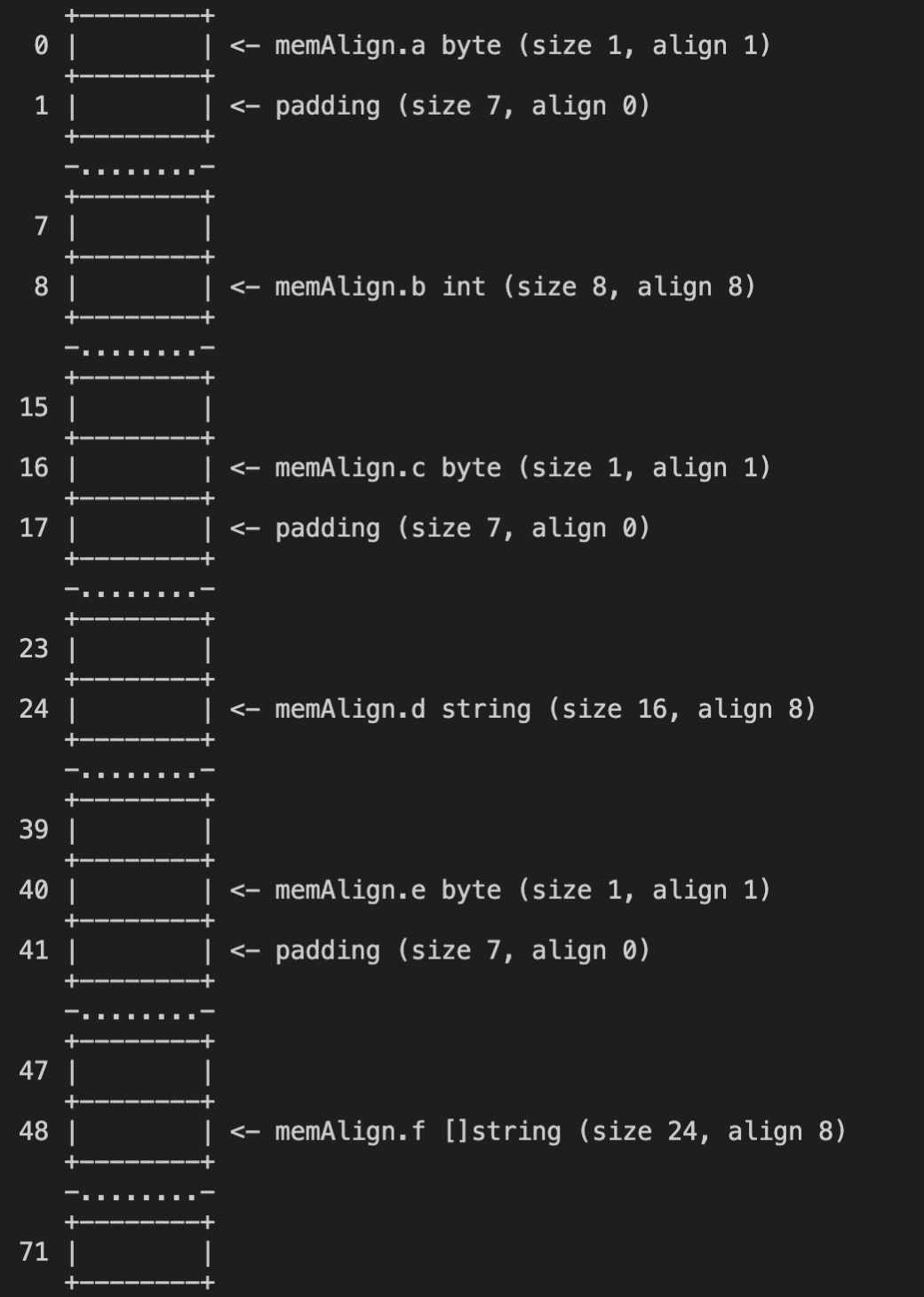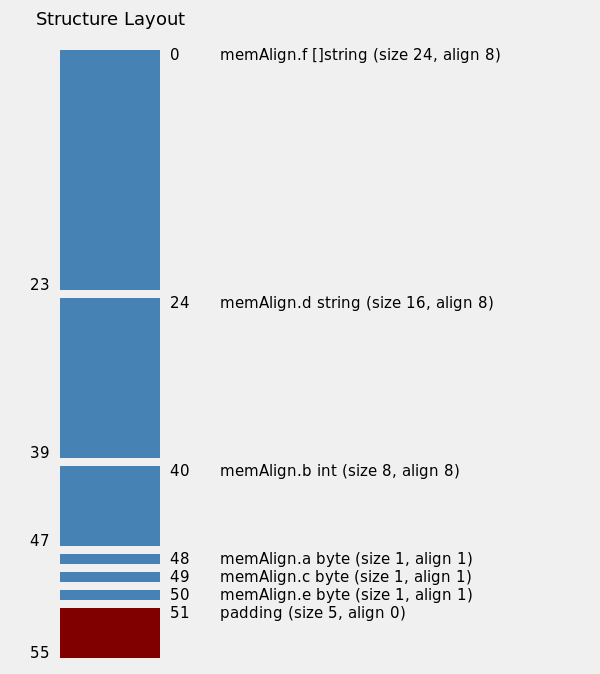浅谈Golang内存对齐
如果你在 golang spec[1] 里以「alignment」为关键字搜索的话,那么会发现与此相关的内容并不多,只是在结尾介绍 unsafe 包的时候提了一下,不过别忘了字儿越少事儿越大:
Computer architectures may require memory addresses to be aligned; that is, for addresses of a variable to be a multiple of a factor, the variable’s type’s alignment. The function Alignof takes an expression denoting a variable of any type and returns the alignment of the (type of the) variable in bytes. For a variable x:
uintptr(unsafe.Pointer(&x)) % unsafe.Alignof(x) == 0
The following minimal alignment properties are guaranteed:
For a variable x of any type: unsafe.Alignof(x) is at least 1. For a variable x of struct type: unsafe.Alignof(x) is the largest of all the values unsafe.Alignof(x.f) for each field f of x, but at least 1. For a variable x of array type: unsafe.Alignof(x) is the same as the alignment of a variable of the array’s element type.
当然,如果你以前没有接触过内存对齐的话,那么对你来说上面的内容可能过于言简意赅,在继续学习之前我建议你阅读以下资料,有助于消化理解:
图解 Go 之内存对齐[2] 在 Go 中恰到好处的内存对齐[3] Go 结构体的内存布局[4] Golang 是否有必要内存对齐[5]
测试
我构造了一个 struct,它有一个特征:字段按照一小一大的顺序排列,如果不看注释中的 Sizeof、Alignof、Offsetof 信息(通过 unsafe 获取),你能否说出它占用多少个字节?
package main
import (
"fmt"
"unsafe"
)
type memAlign struct {
a byte // Sizeof: 1 Alignof: 1 Offsetof: 0
b int // Sizeof: 8 Alignof: 8 Offsetof: 8
c byte // Sizeof: 1 Alignof: 1 Offsetof: 16
d string // Sizeof: 16 Alignof: 8 Offsetof: 24
e byte // Sizeof: 1 Alignof: 1 Offsetof: 40
f []string // Sizeof: 24 Alignof: 8 Offsetof: 48
}
func main() {
var m memAlign
fmt.Println(unsafe.Sizeof(m))
}
初学者往往会认为 struct 的大小应该等于内部各个字段大小的和,于是得出本例的答案是 51(1+8+1+16+1+24=51),不过实际上答案却是 72!究其原因是因为内存对齐的缘故导致各个字段之间可能存在 padding。那么有没有简单的方法来减少 padding 呢?我们不妨把字段按照从大到小的顺序排列,再试一试:
package main
import (
"fmt"
"unsafe"
)
type memAlign struct {
f []string // Sizeof: 24 Alignof: 8 Offsetof: 0
d string // Sizeof: 16 Alignof: 8 Offsetof: 24
b int // Sizeof: 8 Alignof: 8 Offsetof: 40
a byte // Sizeof: 1 Alignof: 1 Offsetof: 48
c byte // Sizeof: 1 Alignof: 1 Offsetof: 49
e byte // Sizeof: 1 Alignof: 1 Offsetof: 50
}
func main() {
var m memAlign
fmt.Println(unsafe.Sizeof(m))
}
结果答案变成了 56,比 72 小了很多,不过还是比 51 大,说明还是存在 padding,这是因为不仅字段要内存对齐,struct 本身也要内存对齐。
另:我刚学 golang 的时候一直有一个疑问:为什么切片的大小是 24,字符串的大小是 16 呢?我估计别的初学者也会有类似的问题,一并解释一下,这是因为切片和字符串也是 struct,其定义分别对应 SliceHeader[6] 和 StringHeader[7],它们的大小分别是 24 和 16:
type SliceHeader struct {
Data uintptr
Len int
Cap int
}
type StringHeader struct {
Data uintptr
Len int
}
因为 uintptr 的大小等于 int,所以切片的大小等于 3*8=24,字符串的大小等于 2*8=16。
工具
只要我们写点代码,调用 unsafe 包的 Sizeof、Alignof、Offsetof 等方法,那么就可以搞清楚 struct 内存对齐的各种细节,不过这毕竟是个没有技术含量的体力活,有没有相关工具可以提升我们的工作效率呢?答案是 go-tools[8]:
shell> go install honnef.co/go/tools/cmd/structlayout@latest
shell> go install honnef.co/go/tools/cmd/structlayout-pretty@latest
shell> go install honnef.co/go/tools/cmd/structlayout-optimize@latest
其中,structlayout 是用来分析数据的,pretty 是用来图形化显示的,optimize 是用来优化建议的,这里就用文章开头优化前的代码给出一个 structlayout-pretty 的例子:
shell> structlayout -json ./main.go memAlign | structlayout-pretty

虽然 structlayout-pretty 我们可以很直观的看到在哪里存在 padding,不过它是 ascii 风格的,有时候不太方便,此时另外一个图形化工具 structlayout-svg[9] 更爽:
shell> go install github.com/ajstarks/svgo/structlayout-svg@latest
把文章开头优化前后的代码分别用 structlayout-svg 生成结果:
shell> structlayout -json ./main.go memAlign | structlayout-svg
优化前:

优化后:

效果超赞是不是!不过如果我们要把工具集成到 CI 里,那么此类图形化工具就不合适了,好在我们的工具箱里还有宝贝,它就是 fieldalignment[10]:
shell> go install golang.org/x/tools/...@latest
把文章开头优化前后的代码分别用 fieldalignment 生成结果:
shell> awk '$1 == "module" {print $2}' ./go.mod | xargs fieldalignment
优化前:struct of size 72 could be 56;优化后:struct with 32 pointer bytes could be 24。
如上可见,fieldalignment 准确判断出优化前代码的 struct size 存在优化空间;但是优化后代码的 pointer bytes 是什么鬼?按照文档中的说明,pointer bytes 的含义如下:
Pointer bytes is how many bytes of the object that the garbage collector has to potentially scan for pointers, for example:
struct { uint32; string }
have 16 pointer bytes because the garbage collector has to scan up through the string’s inner pointer.
struct { string; *uint32 }
has 24 pointer bytes because it has to scan further through the *uint32.
struct { string; uint32 }
has 8 because it can stop immediately after the string pointer.
看到这里,不禁让人产生疑惑:GC 不会这么傻吧,难道它还要一个字节一个字节的扫描内存么?让我们做个实验测试一下 pointer bytes 有没有影响,正所谓有病没病走两步:
package main
import (
"runtime"
"time"
)
// pointer bytes: 8
type foo struct {
S string
U uint32
}
// pointer bytes: 16
type bar struct {
U uint32
S string
}
// GODEBUG=gctrace=1 go run main.go
func main() {
v := make([]foo, 1e8)
// v := make([]bar, 1e8)
for range time.Tick(time.Second) {
runtime.GC()
}
runtime.KeepAlive(v)
}
代码里构造了一个巨大的切片变量,栈必然保存不了,于是变量会逃逸到堆,接着周期性的调用 runtime.GC 来手动触发 GC,然后执行的时候通过 GODEBUG=gctrace=1 获取实时的 GC 相关信息。结果显示,不管是小 pointer bytes 的 foo,还是大 pointer bytes 的 bar,最终 GC 消耗的时间差不多。换句话说,pointer bytes 的大小对 GC 的影响很小很小,在 golang 的相关 issue[11] 的讨论中,也能印证此结论,篇幅所限,这里就不多说了。
另:命令输出的 gctrace 信息比较多,相关格式说明可以参考 runtime[12] 中的注释信息。
例子
了解了内存对齐的相关知识后,让我们看看现实世界中的例子,首先是 groupcache[13]:
type Group struct {
name string
getter Getter
peersOnce sync.Once
peers PeerPicker
cacheBytes int64
mainCache cache
hotCache cache
loadGroup flightGroup
_ int32 // force Stats to be 8-byte aligned on 32-bit platforms
Stats Stats
}
通过注释我们可以看到,为了强制让 Stats 在 32 位平台上按 8 字节对齐,在 Stats 字段的前面加了一个「_ int32」,换句话说,就是加了 4 个字节,那么为什么要这么做?
原因是 Stats 字段要参与 atomic 原子运算,关于 atomic[14],文档最后记录了如下内容:
On ARM, 386, and 32-bit MIPS, it is the caller’s responsibility to arrange for 64-bit alignment of 64-bit words accessed atomically. The first word in a variable or in an allocated struct, array, or slice can be relied upon to be 64-bit aligned.
也就是说,在 32 位平台,调用者有责任自己保证原子操作是 64 位对齐的,此外,struct 中第一个字段可以被认为是 64 位对齐的。在本例中,因为 Stats 字段要参与 atomic 运算,而且不是第一个字段,所以我们必须手动保证它是 64 位对齐的,不过加了 _ int32 就能保证是 64 位对齐的么?让我们写代码验证一下:
package main
import (
"fmt"
"unsafe"
"github.com/golang/groupcache"
)
// GOARCH=386 go run main.go
func main() {
var g groupcache.Group
fmt.Println(unsafe.Offsetof(g.Stats))
}
结果显示在 32 位下运行,Stats 的 offset 是 176,是 8 的倍数,满足 64 位对齐。如果没有「_ int32」做 padding,那么 Stats 的 offset 将是 172,就不再是 8 的倍数了。
…
再看看 sync.WaitGroup 中内存对齐的例子:
type WaitGroup struct {
noCopy noCopy
// 64-bit value: high 32 bits are counter, low 32 bits are waiter count.
// 64-bit atomic operations require 64-bit alignment, but 32-bit
// compilers do not ensure it. So we allocate 12 bytes and then use
// the aligned 8 bytes in them as state, and the other 4 as storage
// for the sema.
state1 [3]uint32
}
func (wg *WaitGroup) state() (statep *uint64, semap *uint32) {
if uintptr(unsafe.Pointer(&wg.state1))%8 == 0 {
return (*uint64)(unsafe.Pointer(&wg.state1)), &wg.state1[2]
} else {
return (*uint64)(unsafe.Pointer(&wg.state1[1])), &wg.state1[0]
}
}
首先,noCopy 是什么鬼,其实它的作用就像名字一样,它是如何实现的呢,看注释:
// noCopy may be embedded into structs which must not be copied
// after the first use.
//
// See https://golang.org/issues/8005#issuecomment-190753527
// for details.
type noCopy struct{}
// Lock is a no-op used by -copylocks checker from `go vet`.
func (*noCopy) Lock() {}
func (*noCopy) Unlock() {}
实际上它只是起到标识的作用,以便 go vet 能够借此发现问题,详细说明在 issue[15] 中有描述,如果你在自己的项目里有类似 noCopy 的需求,那么也可以照猫画虎,
接下来是内存对齐相关的重头戏了,state1 字段是一个有 3 个元素的 uint32 数组,它会保存两种数据,分别是 statep 和 semap,其中,statep 要参与 atomic 运算,所以我们要保证它是 64 位对齐的。如果「uintptr(unsafe.Pointer(&wg.state1))%8 == 0」成立,那么取前两个 int32 做 statep,否则取后两个 int32 做 statep。
为什么可以这样做?因为「uintptr(unsafe.Pointer(&wg.state1))%8 == 0」成立的时候,前两个 int32 自然满足 64 位对齐;当「uintptr(unsafe.Pointer(&wg.state1))%8 == 0」不成立的时候, 其运算结果必然等于 4,此时我们正好可以把第一个 int32 当作是一个 4 字节的 padding,于是后两个字节的 int32 就又满足 64 位对齐了。
如果你认为自己理解了,那么思考一下,在定义 state1 的时候,如果不用 [3]int32,而是换成一个 int64 加上一个 int32,或者是一个 [12]byte,它们都是 12 个字节,是否可以?
参考资料
golang spec: https://golang.org/ref/spec
[2]图解 Go 之内存对齐: http://blog.newbmiao.com/slides/%E5%9B%BE%E8%A7%A3Go%E4%B9%8B%E5%86%85%E5%AD%98%E5%AF%B9%E9%BD%90.pdf
[3]在 Go 中恰到好处的内存对齐: https://eddycjy.gitbook.io/golang/di-1-ke-za-tan/go-memory-align
[4]Go 结构体的内存布局: https://www.liwenzhou.com/posts/Go/struct_memory_layout/
[5]Golang 是否有必要内存对齐: https://ms2008.github.io/2019/08/01/golang-memory-alignment/
[6]SliceHeader: https://pkg.go.dev/reflect#SliceHeader
[7]StringHeader: https://pkg.go.dev/reflect#StringHeader
[8]go-tools: https://github.com/dominikh/go-tools
[9]structlayout-svg: https://github.com/ajstarks/svgo/tree/master/structlayout-svg
[10]fieldalignment: https://github.com/golang/tools/blob/master/gopls/doc/analyzers.md#fieldalignment
[11]issue: https://github.com/golang/go/issues/44877#issuecomment-794565908
[12]runtime: https://pkg.go.dev/runtime
[13]groupcache: https://github.com/golang/groupcache/blob/master/groupcache.go
[14]atomic: https://pkg.go.dev/sync/atomic
[15]issue: https://github.com/golang/go/issues/8005#issuecomment-190753527
推荐阅读
